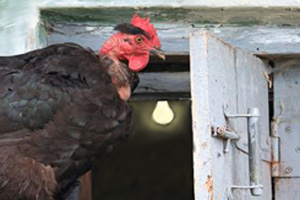Chickens see the light thanks to Henlight trio

Sometimes a tiny innovation is all you need to crack the world’s toughest problems. For example, a small solar-powered LED light placed in a chicken coop in a developing country. Can something that small solve an issue that is affecting the world?
The light stretches winter daylight hours, boosts the hens’ egg production, puts a reliable supply of nutritious food on the farmer’s table and moves a nation a step closer to food security.
The meticulously strategised dream of three young visionaries, all affiliated with the University of California, Davis. The trio, calling themselves Henlight, will travel to Berlin, Germany (Wednesday 18 September) as one of five teams from across the globe competing for investment funding in the finals of the international 2013 Thought for Food Challenge Summit.
The team’s palm-sized product is a modified version of a light developed several years ago by researchers at the UC Davis Program for International Energy Technologies. In the summer of 2012, following graduation, Silva and a colleague ran the original prototype through a pilot test in homes located in rural communities near to cities in Zambia.
Since then, the light has been developed and modified for application in poultry operations, where it can be used to stimulate chickens to lay more eggs – and do so more consistently – during the shorter days of the year.
The hope is that the light will result in greater access to food that is produced using sustainable, localised and energy-efficient methods — without disturbing the chickens’ natural behavior.
“Farmers should receive roughly 40% to 80% more eggs during periods of shorter day length than they would without using the supplemental lighting,” Silva said. “For a small flock of 10 birds, that can mean up to 40 extra eggs per week during the autumn and winter months.”
There they conducted research on entrepreneurial and market behaviours related to the light. The team believes that chickens hold a critical role in addressing the world’s challenge to produce massive quantities of nutritionally rich foods while minimising negative impacts on the environment.
Silva noted that this process is already done successfully in large-scale, global egg production. “Our contribution is in making these techniques available to small-scale farmers by developing a light source that is affordable and appropriate—factors that are vital for successful agricultural innovations,¨ said Silva, who grew up on a small farm in California’s Central Valley.
Source: UCA
Join 31,000+ subscribers
Subscribe to our newsletter to stay updated about all the need-to-know content in the poultry sector, three times a week. Beheer
Beheer











 WP Admin
WP Admin  Bewerk bericht
Bewerk bericht